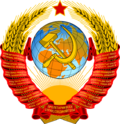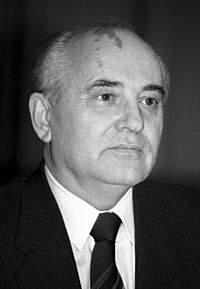President of the Soviet Union facts for kids
Quick facts for kids President of the Unionof Soviet Socialist Republics |
|
|---|---|

Coat of arms of the Soviet Union (1956–1991)
|
|
| Presidium of the Supreme Soviet Government of the Soviet Union |
|
| Style | Mr. President (informal) His Excellency (diplomatic) Comrade Supreme Commander (military) |
| Residence | Kremlin Senate, Moscow |
| Appointer |
|
| Precursor | Presidium of the Supreme Soviet (as head of state) |
| Formation | 15 March 1990 |
| First holder | Mikhail Gorbachev |
| Final holder | Mikhail Gorbachev |
| Abolished | 25 December 1991 |
| Succession | None (USSR dissolved) |
The President of the Soviet Union was the top leader of the Union of Soviet Socialist Republics (USSR) from March 15, 1990, to December 25, 1991. This important job was created to be the country's main executive leader.
Mikhail Gorbachev was the only person who ever held this position. He was also the General Secretary of the Communist Party of the Soviet Union for many years. After a failed attempt to overthrow the government in 1991, Gorbachev's power as president grew even more.
Contents
History of the Presidency
The idea of having one single leader for the Soviet Union first came up a long time ago. This was during the planning of the 1936 Constitution of the Soviet Union. However, Joseph Stalin, who was the most powerful person at the time, did not like this idea.
Stalin believed that a single president might become too powerful. He thought it was better for a group of people to lead the country. This group was called the Presidium of the Supreme Soviet. He said this group leadership was more democratic and safer for the country.
Later, the idea of a president came up again when new constitutions were being written. This happened in the 1960s under Nikita Khrushchev and in the 1970s under Leonid Brezhnev. But each time, the country decided to stick with the group leadership of the Presidium.
Finally, members of the Communist Party voted to create the presidency on February 7, 1990. The first and only presidential election happened on March 14, 1990. The Congress of People's Deputies of the Soviet Union chose the first president. They planned for future presidents to be elected by the public.
What the President Could Do
The President of the Soviet Union had many important jobs and powers. This role was a mix of how the presidents in the United States and France operate.
Before the president's job was created, the official head of the Soviet Union was the chairman of the Presidium of the Supreme Soviet. However, the real power was usually held by the General Secretary of the Communist Party of the Soviet Union. The chairman of the Presidium mostly had a symbolic role.
The president was initially chosen by the Congress of People's Deputies of the Soviet Union. The president also led this Congress. Later, it was planned that the public would vote for the president. The president had to report to the Supreme Soviet.
In September 1990, Mikhail Gorbachev was given special powers. He could make decisions about the economy, law, and order without needing full approval. He could also declare special presidential rule in troubled areas.
Here are some of the president's main powers:
- Being the top commander of the country's armed forces.
- Suggesting new laws and stopping laws he disagreed with.
- Choosing the Prime Minister and other government officials. The Supreme Soviet had to approve the Prime Minister.
- Declaring states of emergency or martial law in the Soviet Union.
- Representing the country to other nations and signing international agreements.
- Calling for national votes (referendums) on important issues.
- Giving military ranks and special honorary titles.
- Allowing people who had been exiled or were against the government to return.
- Overruling government decisions that went against the constitution or citizens' rights.
The Vice President of the Soviet Union was the second-in-command. If the president could not do their job, the vice president would take over. Gennady Yanayev was the only person to be Vice President. He briefly became acting president during a coup attempt in August 1991. After three days, the coup failed, and Gorbachev returned to his role.
Gorbachev remained president until the Soviet Union broke apart in December 1991. He then resigned, and the job of president ended. The powers of the position were then passed to the new President of Russia, Boris Yeltsin.
The Presidential Oath
When Mikhail Gorbachev became president, he took an important oath. He placed his right hand on a copy of the Soviet Constitution. He promised to serve the people of the Soviet Union faithfully. He also swore to follow the Constitution and protect the rights of citizens.
Presidential Administration
The President had several groups and councils that helped him lead the country:
- State Council of the Soviet Union
- Presidential Council
- Political Advisory Council under the President
- Federation Council
- Defense Council
- Security Council
List of Presidents
| No. | Portrait | Name (Born-Died) |
Term of office | Political Party | Election | Vice President | Prime Ministers | |||
|---|---|---|---|---|---|---|---|---|---|---|
| Took office | Left office | Time in office | ||||||||
| 1 |  |
Mikhail Gorbachev (1931–2022) |
15 March 1990 | 25 December 1991 | 1 year, 285 days | Communist Party of the Soviet Union |
1990 | Office vacant (until 27 December 1990) |
Nikolai Ryzhkov | |
| Gennady Yanayev | Valentin Pavlov | |||||||||
| Office abolished (after 21 August 1991) |
Ivan Silayev | |||||||||
| — | Gennady Yanayev (1937–2010) Acting |
19 August 1991 | 21 August 1991 | 2 days | Communist Party of the Soviet Union |
— | Office vacant | Valentin Pavlov | ||
| — | Office vacant | 25 December 1991 | 26 December 1991 | 1 day | — | — | Office vacant | Office vacant | ||
See also
 In Spanish: Presidente de la Unión Soviética para niños
In Spanish: Presidente de la Unión Soviética para niños


